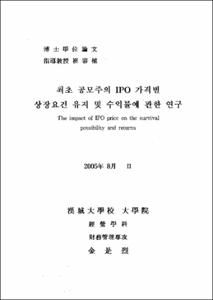최초 공모주의 IPO 가격별 상장요건 유지 및 수익률에 관한 연구
- Files in This Item:
-
-
Download
 000000556989.pdf
기타 데이터 / 2.96 MB / Adobe PDF
000000556989.pdf
기타 데이터 / 2.96 MB / Adobe PDF
-
Items in Repository are protected by copyright, with all rights reserved, unless otherwise indicated.
 000000556989.pdf
기타 데이터 / 2.96 MB / Adobe PDF
000000556989.pdf
기타 데이터 / 2.96 MB / Adobe PDFItems in Repository are protected by copyright, with all rights reserved, unless otherwise indicated.